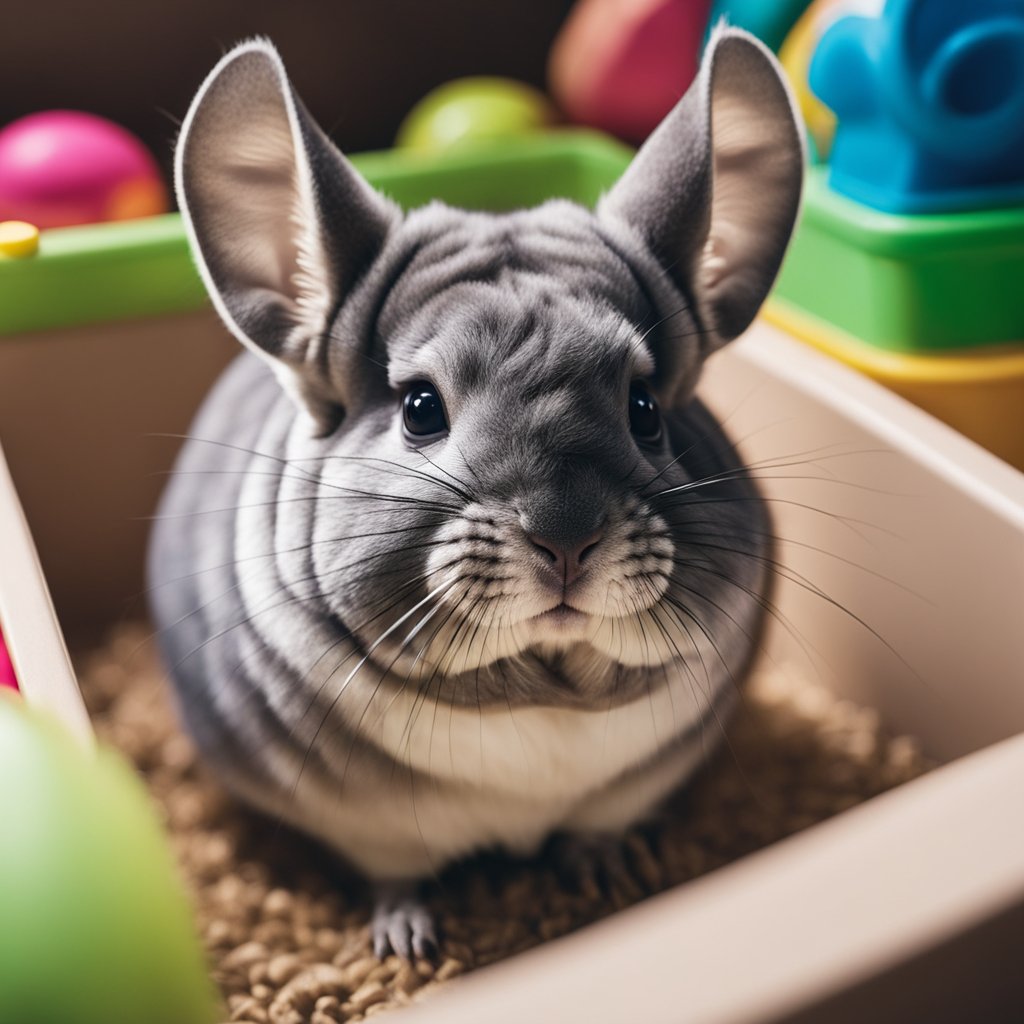Chinchillas are adorable pets known for their soft fur and playful nature. You may be wondering if these unique creatures can be trained to use a litter box. The good news is that chinchillas can be somewhat litter box trained, although it’s not as effective as with other types of pets. Your chinchilla might learn to use a designated area, making cleanup easier and helping to keep their space tidy.

Potty training requires patience and the right techniques. Many owners report success by placing a small litter tray in a corner of their chinchilla’s cage. It may take some time for your pet to get the hang of it, but with consistent effort, you can encourage them to use the tray more often.
Understanding your chinchilla’s habits and behaviors is key to successful training. This article will provide tips and insights to help you navigate the process of litter box training your chinchilla effectively.
Key Takeaways
- Chinchillas can be partially litter box trained with the right approach.
- Patience and consistency are essential for successful training.
- Learning about your chinchilla’s behavior aids in the training process.
Understanding Chinchillas

Chinchillas are unique animals with distinct behaviors and natural habitats. Knowing these traits will help you understand how to care for them effectively, including how to approach litter box training.
Natural Habitat and Behaviors
Chinchillas are native to the Andes Mountains in South America. In the wild, they live in rocky, mountainous areas where they can jump and climb. This requires them to have strong legs and excellent agility.
They are social creatures, often living in groups. In your home, they may show similar social behaviors, seeking interaction with you and other pets. Chinchillas also have specific routines, often being most active during dawn and dusk.
When considering litter box training, keep in mind their natural tendency to choose a corner for toilet needs. Placing a litter box in that area can make training easier. You can use a litter box made specifically for chinchillas with chinchilla-safe litter for comfort and safety.
Differences from Other Pets
Chinchillas differ significantly from common pets like dogs and cats. While dogs are territorial and cats might use a litter box instinctively, chinchillas need gentle guidance.
Chinchillas have sensitive skin, which means you should avoid harsh bedding materials. Their digestive systems are also different; they require a high-fiber diet, mainly consisting of hay and pellets.
Understanding their unique needs is crucial. Unlike other animals that may need frequent walking or outside time, chinchillas thrive in a safe, enclosed space with toys and hideouts. When training, patience is vital, as chinchillas may take longer to adapt than typical pets.
Litter Box Training for Chinchillas

Litter box training can make caring for your chinchilla easier and keep their environment clean. This section will cover the essential steps and considerations for successfully training your chinchilla to use a litter box.
Training Basics
To start litter box training, patience is key. Chinchillas tend to choose a specific spot in their cage to urinate, making it easier for you to place the litter box there. Observe your chinchilla for a few days to identify this spot.
Introduce the litter box by placing it where your chinchilla naturally eliminates. Encourage them to use it by placing some soiled bedding inside. This familiar scent helps them understand the purpose of the box.
Consistency is crucial. Reward your chinchilla with treats when they use the litter box correctly. If they forget, don’t punish them. Instead, redirect them back to the box gently. Over time, they will learn where to go.
Choosing the Right Litter Box
Selecting the right litter box is important for successful training. There are various designs available, including trays and boxes with low sides for easy entry.
Key factors to consider:
- Size: The box should fit in your chinchilla’s cage without crowding the space. It should also be large enough for your chinchilla to turn around comfortably.
- Accessibility: Chinchillas are small animals, so the entrance should be low for easy access.
- Material: Look for non-toxic and chew-resistant materials. This ensures safety and durability.
You might also consider using a glass or ceramic dish. These are easy to clean and won’t absorb odors over time.
Selection of Appropriate Litter Material
Not all litter materials are safe for chinchillas. It’s important to choose a suitable option that is safe for their health and effectively absorbs waste.
Recommended materials include:
- Chinchilla-safe litter: Look for brands that specify they are safe for small animals.
- Fleece bedding: This can be placed in the litter box to encourage your chinchilla to use it. However, make sure to change it regularly.
- Aspen shavings: These are a popular choice because they are absorbent and safe.
Avoid using clumping cat litter, clay-based litter, or any scented products. These can be harmful to your chinchilla’s respiratory system and may lead to health issues.
Maintenance and Hygiene
Regular maintenance is necessary to keep the litter box sanitary and odor-free. Clean the box at least once a week, or more often if needed.
Cleaning tips:
- Daily checks: Remove soiled litter and waste to prevent buildup.
- Deep cleaning: Use a pet-safe disinfectant to scrub the box every few weeks.
- Replace litter: Change the materials thoroughly during your deep cleaning session.
By keeping the litter box clean, you help maintain a healthy environment for your chinchilla and encourage them to continue using it. Regular maintenance reduces odors and keeps their space inviting.
Resources

Potty training a chinchilla can be made easier with the right information and tools. Here are some valuable resources for you.
Websites
- How to Potty Train a Chinchilla: This site provides a step-by-step guide on the process and items you’ll need.
- Do Chinchillas Need a Litter Box?: This article discusses whether a litter box is necessary and alternative bedding options.
Tips
- Start training when your chinchilla is young. Early training can lead to better results.
- Monitor your chinchilla’s behavior to identify their preferred potty spot.
Supplies
- Litter Box: Choose a box designed for chinchillas.
- Chinchilla-safe Litter: Look for non-toxic options specifically for small animals.
- Bedding: Having some used bedding can help your chinchilla feel familiar with the box.
Training a chinchilla takes time and patience. The resources above can guide you through the process effectively.
Frequently Asked Questions

Litter training your chinchilla can be a rewarding process. Knowing how to do it effectively, what materials to use, and how to address any challenges will help you succeed.
How can I effectively litter train my chinchilla?
To begin litter training, identify a spot in your chinchilla’s cage where it usually goes to the bathroom. Place a litter box filled with chinchilla-safe litter in that area. During training, reward your chinchilla with treats when it uses the box to reinforce the behavior.
What types of litter are considered safe for chinchillas?
Safe litter options for chinchillas include aspen shavings, paper-based litter, or specific chinchilla litter. Avoid clay-based litters, as they can be harmful. Use bedding that does not have added scents or chemicals to ensure your pet’s safety.
Is it possible for chinchillas to freely roam around the house?
Chinchillas can roam the house, but it’s essential to supervise them closely. Create a safe area free from hazards such as electrical cords or other pets. Remember to set up a designated space where they can use their litter box during playtime.
What are the best practices for managing chinchilla waste?
Regularly clean the litter box to maintain a hygienic environment for your chinchilla. Replace soiled litter and wash the box with mild soap and water. This will help prevent odors and keep your pet healthy.
How long does it typically take to litter train a chinchilla?
Training duration can vary but often takes several weeks. Consistency is key, so be patient and continue reinforcing positive behavior with treats and praise.
What should I do if my chinchilla is not using the litter box?
If your chinchilla is not using the litter box, check the placement and cleanliness of the box. Make sure it’s located in a familiar spot. If issues persist, consider trying different types of litter or consulting a veterinarian for advice.

